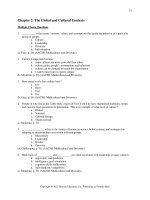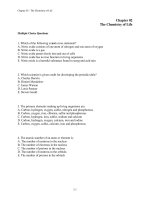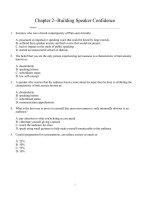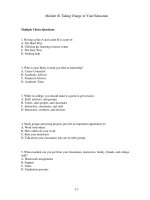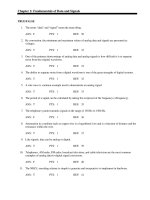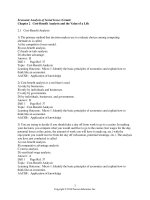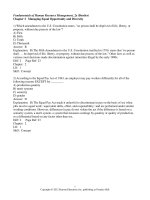Preliminary edition of statistics learning from data 1st edition roxy peck test bank
Bạn đang xem bản rút gọn của tài liệu. Xem và tải ngay bản đầy đủ của tài liệu tại đây (696.69 KB, 36 trang )
Chapter 02 - Graphical Methods for Describing Data Distributions
TRUE/FALSE
1. A data set is discrete if the possible values are isolated points on the number line.
ANS: T
PTS: 1
MSC: Section 2.1 College
REF: Section 2.1 AP
2. A data set consisting of many observations of a single characteristic is a categorical data set.
ANS: F
PTS: 1
MSC: Section 2.1 College
REF: Section 2.1 AP
3. A data set is multivariate if it consists only of numeric variables.
ANS: F
PTS: 1
MSC: Section 2.1 College
REF: Section 2.1 AP
4. Frequency distributions can only be used with categorical data.
ANS: F
PTS: 1
MSC: Section 2.2 College
REF: Section 2.2 AP
5. The relative frequency for a particular category is the number of times the category appears in the data.
ANS: F
PTS: 1
MSC: Section 2.2 College
REF: Section 2.2 AP
6. Bar charts should be used with categorical data.
ANS: T
PTS: 1
MSC: Section 2.2 College
REF: Section 2.2 AP
7. Dotplots work best for small and moderate sized numerical data sets.
ANS: T
PTS: 1
MSC: Section 2.3 College
REF: Section 2.3 AP
8. An outlier is an unusually small or large data value.
ANS: T
PTS: 1
MSC: Section 2.3 College
9. The quantity
intervals in a histogram.
ANS: T
PTS: 1
MSC: Section 2.3 College
REF: Section 2.3 AP
often gives a rough estimate of the appropriate number of
REF: Section 2.3 AP
10. A curve with tails that decline more rapidly than the tails of a normal curve is called a heavy-tailed
distribution.
ANS: F
PTS: 1
MSC: Section 2.3 College
REF: Section 2.3 AP
11. The density of a class can be calculated by multiplying the relative frequency of the class times the
class width.
ANS: F
PTS: 1
MSC: Section 2.3 College
REF: Section 2.3 AP
12. For stem and leaf plots with single-digit leaves, commas must be used to separate the leaves.
ANS: F
PTS: 1
MSC: Section 2.3 College
REF: Section 2.3 AP
13. One advantage of histograms is that they may be used for large data sets.
ANS: T
PTS: 1
MSC: Section 2.3 College
REF: Section 2.3 AP
14. If the upper tail of a distribution stretches out farther than the lower tail, the distribution is negatively
skewed.
ANS: F
PTS: 1
MSC: Section 2.3 College
REF: Section 2.3 AP
15. In a scatter plot, both the horizontal and vertical axes must be set at zero.
ANS: F
PTS: 1
MSC: Section 2.4 College
REF: Section 2.4 AP
16. A pie chart is most useful for numeric data.
ANS: F
PTS: 1
MSC: Section 2.5 College
REF: Section 2.5 AP
MULTIPLE CHOICE
17. A survey form solicited the following responses:
I). age of respondent
II). gender of respondent
III). level of job satisfaction (completely dissatisfied/somewhat dissatisfied/somewhat
satisfied/completely satisfied)
IV). annual income
Which of the responses represent categorical data?
a.
b.
c.
d.
e.
I only
II only
III only
II and III only
All the responses are categorical.
ANS: D
PTS: 1
MSC: Section 2.1 College
REF: Section 2.1 AP
18. The following relative frequency distribution summarizes student responses to the question “If you
could make your college choice over, would you still choose to enroll at your current college?”
Response
Definitely yes
Probably yes
Probably no
Definitely no
Relative Frequency
0.45
0.33
0.13
0.09
Which of the following is the correct bar chart for the response data?
a.
d.
b.
e.
c.
ANS: E
PTS: 1
MSC: Section 2.2 College
REF: Section 2.2 AP
19. Which of the following variables are discrete?
I). the volume of liquid in a 16-ounce bottle of soda pop
II). the percentage of males 18-25 who actively view online pornography
III). the number of broken eggs in a package of a dozen eggs
IV). a count of the statistics majors at a certain university
a.
b.
c.
d.
e.
II only
II and III only
III and IV only
I only
All of these variables are discrete.
ANS: C
PTS: 1
MSC: Section 2.1 College
REF: Section 2.1 AP
20. A survey asked adult respondents how dependent they were on various electronic devices. The
accompanying table summarizes the responses.
Response
Cannot imagine living
without
Would miss but could do
without
Could definitely live
without
Relative Frequency
Cell Phone
DVD Player
Personal
Computer
0.25
0.42
0.15
0.45
0.20
0.35
0.30
0.38
0.50
Select a comparative bar chart that shows the distributions of responses for the three different
technologies.
a.
d.
b.
e.
c.
ANS: B
PTS: 1
MSC: Section 2.2 College
REF: Section 2.2 AP
21. According to the stem-and-leaf display below, how many times does the number 58 appear in the data
set?
a.
b.
c.
d.
e.
0
1
2
5
58
ANS: C
PTS: 1
MSC: Section 2.3 College
REF: Section 2.3 AP
22. Which of the following stem and leaf plots corresponds a data distribution that is positively (right)
skewed?
I.
a.
b.
c.
d.
e.
II.
III.
I only
II only
III only
I and III only
None of the distributions is positively skewed.
ANS: B
PTS: 1
REF: Section 2.3 AP
MSC: Section 2.3 College
23. The annual household incomes, in thousands of dollars, for 150 households in a small community are
summarized in the histogram below.
What proportion of households have annual incomes of $90,000 or more?
a.
b.
c.
d.
e.
0.85
0.67
0.08
0.15
0.11
ANS: D
PTS: 1
MSC: Section 2.4 College
REF: Section 2.4 AP
24. The annual household incomes, in thousands of dollars, for 500 households in a small community are
summarized in the histogram below.
Which of the following values best describes a typical household income for this community?
a.
b.
c.
d.
e.
$40,000
$50,000
$60,000
$70,000
$80,000
ANS: C
PTS: 1
MSC: Section 2.3 College
REF: Section 2.3 AP
25. The frequency distribution shown summarizes data on the percentage of college students enrolled in
public institutions for the 50 U.S. states.
Percentage Enrolled
40 to < 50
50 to < 60
60 to < 70
70 to < 80
80 to < 90
90 to < 100
Frequency
1
5
2
11
25
6
What is the relative frequency for the 70 to < 80 interval?
a.
b.
c.
d.
e.
0.05
0.10
0.22
11
50
ANS: C
PTS: 1
MSC: Section 2.2 College
REF: Section 2.2 AP
26. The cumulative relative frequency plot shown was constructed using data on the percentage of college
students enrolled in public institutions for the 50 U.S. states. Which of the following is closest to the
approximate proportion of states that have more than 90 percent of college students enrolled in public
institutions?
a.
b.
c.
d.
e.
0.6
0.1
0.0
0.4
0.9
ANS: B
MSC: N/A
SHORT ANSWER
PTS: 1
REF: Section 2.3 AP
27. In a psychological study of distance perception, introductory psychology class volunteers were given
5, 10, or 15 extra credit points depending on their level of participation in the experiment. They
walked along paths laid out along hallways in the psychology building, and were asked to judge the
distance they had walked. Each path distance was between 100 and 200 feet in length, and contained
from two to seven 90 degree turns. The investigators also kept track of class standing (freshman,
sophomore, junior, or senior). For each of the variables in this study, determine whether it is
categorical or numerical. For each numerical variable, determine whether it is discrete or continuous:
(a)
The true length of the path
(b)
The amount of credit given to the volunteers
(c)
The length of the path as judged by the students
(d)
The number of 90 degree turns
(e)
Class standing
ANS:
a) Numerical, continuous
b) Numerical, discrete
c) Numerical, continuous
d) Numerical, discrete
e) Categorical
PTS: 1
REF: Section 2.1 AP
MSC: Section 2.1 College
28. In a study of how college students give directions from maps, 40 Introductory Psychology volunteers,
20 men and 20 women, were given the task of giving directions to another. Observations were made of
subjects' direction-giving behavior in the experiment:
(a)
(b)
(c)
(d)
(e)
whether the map was available, or the directions were given from memory,
the sex of the direction giver,
the distances given as part of the directions,
the number of times directions such as North, Southwest, etc. were used, and
the frequency of errors in the directions
For each of the variables in this experiment, determine whether it is categorical or numerical. For each
numerical variable, determine whether it is discrete or continuous:
(a)
whether the map was available, or the directions were given from memory
(b)
the sex of the direction giver
(c)
the distances given as part of the directions
(d)
the number of times directions such as North, Southwest, etc. were used
(e)
Frequency of errors in the directions
ANS:
a) Categorical
b) Categorical
c)
d)
e)
Numerical, continuous
Numerical, discrete
Numerical, discrete
PTS: 1
REF: Section 2.1 AP
MSC: Section 2.1 College
29. The most important right and responsibility of citizens in a democratic society is voting. The bar chart
below shows, for different age groups in the 2000 presidential election in the United States, the
percentage of individuals in that age group who are registered to vote.
(a)
Describe in a few sentences the registration pattern that you see in the data above.
(b)
Some individuals argue that the reason for the current level of registration in the 18-24
year-old group is that many of them are college students and would have to vote absentee.
In your opinion, would that explain the registration level for the 18 - 24 age-group? Why or
why not?
ANS:
a) The proportion of people registering is smallest for the 18-24 year-old group, and gets
larger with age, until finally declining in the 75+ year-old group.
b)
Voting by absentee ballot may be more of a hassle b/c you have to get the ballot, but actual
registration could be done at home before going to college. It would seem that unless the
18-24 year-olds decide for some reason they will not vote in their college years because of
expected hassle of voting, the future voting would not be affecting the registration level.
PTS: 1
REF: Section 2.2 AP
MSC: Section 2.2 College
30. Artificial nest have often been used when biologists study predation on birds. It is usually assumed that
predators will respond to artificial nests in the same way they do to real birds' nests. A recent
experiment was performed to check this assumption for predators of the American robin (Turdus
migratorius) by comparing the egg loss in three experimental treatments: (1) natural robin's nests, (2)
artificial wicker-basket nests placed 30 meters in a random direction from natural robin's nests, and (3)
artificial wicker-basket nests placed in a 180 m by 240 m grid around robin's nests. The data below are
cumulative counts of eggs predated (stolen or broken and eaten) at 5, 10, and 15 day points of the
experiment.
Cumulative count of depredated eggs
Nest type
Original n
Day 5 check
Day 10 check
Day 15 check
Natural robin
30 m from robin
Grid
27
27
48
12
3
7
17
12
32
19
18
44
(a)
Construct a bar chart to display the cumulative counts for the natural robin nests at their 5-,
10-, and 15-day checks.
(b)
Fill in the relative frequency distribution (table) representing the cumulative counts for the
artificial nests in the grid. (Do not convert the table to a graph.)
Nest type
Natural robin
30 m from robin
Grid
Original n
27
27
48
Day 5 check
Day 10 check
Day 15 check
Original n
27
27
48
Day 5 check
Day 10 check
Day 15 check
0.146
0.667
0.917
ANS:
a)
b)
Nest type
Natural robin
30 m from robin
Grid
PTS: 1
REF: Section 2.2 AP
MSC: Section 2.2 College
31. Bird-plane collisions
Collisions between birds and airplanes are a major problem, threatening passenger safety and resulting
in costly repairs. During the years 1990 - 1994, researchers gathered bird remains from runways at
Lihue Airport on the island of Kauai, Hawaii. The data below are counts of birds found on the runway
used for takeoffs and the runway used for landings from the 4 most frequently involved species:
Species
Zebra dove
Mannikin spp.
Plover
Barn-owl
Takeoff
49
33
29
6
Landing
68
82
51
39
(a)
Construct a bar chart to display the bird species data for the landing runway.
(b)
Construct a relative frequency distribution (table) representing the bird species data for the
takeoff runway.
ANS:
a)
b)
Species
Zebra dove
Mannikin spp.
Plover
Barn-owl
PTS: 1
Rel. Freq. Takeoff
.4188
.2821
.2479
.0513
REF: Section 2.2 AP
MSC: Section 2.2 College
32. A statewide survey released by the University of Iowa Injury Prevention Research Center was
designed to assess compliance with Iowa seatbelt law. The table below shows the results for 5 Iowa
cities.
City
Belle Plaine
Cedar Rapids
Guttenberg
Iowa City
Manchester
% Age 2 – 5
properly
restrained
84
79
58
92
59
% Age 6-10
properly
restrained
93
94
68
99
82
(a)
Display these data in a comparative bar chart so that the different ages can be compared for
the different cities.
(b)
Write a brief description of the differences and similarities in the patterns you observe in
your bar chart for part (a).
ANS:
(a)
(b)
The patterns across ages are the same for each of the cities--the 6-10 year age group has a
higher level of compliance than the age 2 - 5 group. It appears that generally Belle Plaine,
Cedar Rapids, and Iowa City have higher compliance rates than Guttenberg and
Manchester.
PTS: 1
REF: Section 2.2 AP
MSC: Section 2.2 College
33. One interesting aspect of surveys is that the order of the questions can affect the results. This is
thought to occur because one question can alter the response to a subsequent question. In 1948 many
people in the United States were concerned about the spread of communism as a political and
economic philosophy. A survey given that year contained both of the following questions:
1.
Do you think the United States should let Communist newspaper reporters from other
countries come in here and send back to their papers the news as they see it?
2.
Do you think a Communist country like Russia should let American newspaper reporters
come in and send back to America the news as they see it?
The following table contains the percentages of the Yes/No answers given by respondents when asked
these questions in different orders.
Responses to reporter question in 1948
Question order
Question #1 asked first
Question #2 asked first
% Yes
37
73
% No
63
27
a)
Construct a comparative bar chart for these response percentages.
b)
Interpret the results of the 1948 survey. Do you think the order of the questions made a
difference in the responses? Explain.
ANS:
a)
comparative bar chart:
b)
Yes, the order made a difference. The rate of "yes" responses was very nearly doubled if the
question was asked after the one about American reporters in Russia.
PTS: 1
REF: Section 2.2 AP
MSC: Section 2.2 College
34. Biologists know that bats have different flight characteristics. Some bats exhibit fast, straight, and long
flights; others are moderately slow, and highly maneuverable. The flight capabilities of bats are
presumably a function of (a) the characteristics of the bat wings, and (b) the laws of physics. The data
presented below are wing weights in grams for certain species of bats from Nicaragua and Costa Rica.
Two categories of bat species are represented: fruit-eaters and insect-eaters.
Fruit eaters:
9.9, 11.5, 47.0, 59.6, 18.2, 22.1, 22.9, 15.0, 15.4, 13.3, 38.3, 42.2, 114.3, 105.4, 80.9
Insect eaters:
23.8, 16.1, 4.2, 3.9, 7.5, 3.5, 3.9
(a)
Construct two dotplots that will allow you to easily compare the distributions of the wing
weights for the two categories of bats, fruit-eaters and insect-eaters.
(b)
Write a short paragraph describing the features of the two plots; what do these plots tell you
about the differences in wing weight for fruit- and insect-eaters?
ANS:
a) Fruit Eaters wing weight:
Insect Eaters wing weight:
b)
The fruit eating bats have wings that are generally heavier than those of the insect eating
bats. They are also much more spread out in weight, ranging from 9.9 to 114.3 grams. The
insect-eating bats only have a range of 3.5 to 23.8 grams.
PTS: 1
REF: Section 2.3 AP
MSC: Section 2.3 College
Exhibit 2-1
In a story written in December 2002, the Des Moines Register reported on the average number of years
of teaching experience for the elementary schools in Des Moines, Iowa. The data, by elementary
school, appears in the table below.
School
Adams
Years
Exper
13.8
School
Hanawalt
Years
Exper
12.7
School
McKee
Years
Exper
17.5
School
Phillips
Years
Exper
10.5
Capitol View
9.7
Hillis
17
McKinley
5.6
Pleasant Hill
12.8
Cattell
8.5
Howe
14.9
Mitchell
6.2
River Woods
5.9
Douglas
13.8
Hubbell
15.1
Monroe
16.2
Stowe
16.5
Downtown
7.0
Jackson
16.8
Moore
16.6
Studebaker
18.4
Edmunds
8.4
Jefferson
19.2
Morris
9.9
Wallace
4.8
Findley
14.9
King
7.0
Moulton
8.6
Willard
9.7
Garton
9.3
Longfellow
9.8
Oak Park
11.4
Windson
17.7
Granger
17.2
Lovejoy
9.9
Park Avenue
11.4
Woodlawn
17
Greenwood
14
Madison
20.8
Perkins
11.2
Wright
12.9
35. Refer to Exhibit 2-1.
(a)
Construct a histogram for these data, using the following class intervals:
0 to < 4
5 to < 8, etc.
(b)
Describe the distribution of the average number of years of teaching experience, and note
any unusual features.
ANS:
a)
b)
This is a fairly symmetrical distribution with no apparent outliers. If anything it is slightly
skewed toward the higher values.
PTS: 1
REF: Section 2.3 AP
MSC: Section 2.3 College
Exhibit 2-2
In a story written in December 2002, the Des Moines Register reported on the percentages of students
who qualify for Free/Reduced lunch programs in the elementary schools in Des Moines, Iowa. The
data, by elementary school, appears in the table below.
School
Adams
% F/R
64
School
Hanawalt
% F/R
14
School
McKee
% F/R
55
School
Phillips
% F/R
27
Capitol View
78
Hillis
35
McKinley
78
Pleasant Hill
17
Cattell
55
Howe
49
Mitchell
64
River Woods
48
Douglas
45
Hubbell
31
Monroe
52
Stowe
56
Downtown
8
Jackson
60
Moore
42
Studebaker
30
Edmunds
83
Jefferson
5
Morris
54
Wallace
80
Findley
64
King
71
Moulton
88
Willard
82
Garton
53
Longfellow
84
Oak Park
59
Windson
37
Granger
52
Lovejoy
66
Park Avenue
38
Woodlawn
40
Greenwood
38
Madison
58
Perkins
54
Wright
29
36. Refer to Exhibit 2-2.
(a)
Construct a histogram for these data, using the following class intervals:
0 to < 20
20 to < 40, etc.
(b)
Describe the distribution of Free/Reduced eligibility percents, and note any unusual
features.
ANS:
a)
b)
This distribution is very symmetrical, with no outliers or any skewness. It could be a normal
distribution.
PTS: 1
REF: Section 2.3 AP
MSC: Section 2.3 College
37. Ruminants are hoofed animals such as cattle and sheep. Two categories of ruminants are browsers
(leaf eaters) and grazers (grass eaters). Some biologists believe that the incisor arcade, that part of the
mouth between the incisors, is shaped differently for browsers and grazers, and that might explain their
food selection. The "curvature" of an incisor arcade is a measure of its shape, with large values
indicating a long, thin mouth, and small values a shorter, wider mouth. The back-to-back stem plot
below compares the curvatures of incisor arcades of a sample of species of browsers and grazers in the
ruminant family.
Curvature, Browsers vs. Grazers
Browsers
N = 18
|
|
|
4|
99885 |
410 |
99987 |
321 |
|
|
|
|
0|
Grazers
N = 54
1L
1H
2L
3L
3H
4L
4H
5L
5H
6L
6H
7L
7H
|
|9
|1
| 22244
| 55566667778999999
| 022223
| 55556666677778889
| 03
|9
|0
|
|
|
(a)
Briefly describe each of the two curvature distributions, browsers and grazers, noting any
unusual features of the data.
(b)
The theory of some biologists is that browsers have thinner mouths because the browse
plants frequently have thorns and spines; browsers have evolved to have thinner mouths to
get beyond the thorns and spines to the food part of the plant. Is the data in the back-to-back
stem plot consistent with this theory? What aspect of the data would you consider when
answering this question?
ANS:
a) The distribution of browsers is centered in the low 40 range. Other than one prominent
outlier at 70, the distribution is approximately symmetrical. The distribution of browsers is
likewise centered in the low 40 range and is quite symmetrical, but more spread out than the
browsers if the outlier is excluded.
b)
The evidence to support this theory is not very strong. The browsers may have a slightly
higher average curvature, but the two distributions overlap quite a lot, indicating that the
differences are modest at best.
PTS: 1
REF: Section 2.3 AP
MSC: Section 2.3 College
38. An experiment was performed to determine which brand of comparably priced light bulbs, A or B,
lasts longer on average. Ten bulbs of each brand were tested, and their lifetimes recorded in hours. The
data are shown below:
Bulb A: 88, 97, 110, 122, 128, 129, 135, 141, 150, 165
Bulb B: 23, 55, 93, 106, 111, 115, 123, 128, 153, 171
(a)
Display these data using a comparative (back-to-back) stemplot.
(b)
What are the differences and similarities in the lifetime distributions for the two samples?
(c)
If your preference for brand A or B must be determined from the information in parts (a)
and (b), which brand would you buy? Explain your choice using appropriate statistical
terminology.
ANS:
a) Stemplot: Bulb A vs. Bulb B
Bulb A (hrs)
17
16
15
14
13
12
11
10
9
8
7
6
5
4
3
2
1
0
5
0
1
5
982
0
7
8
Bulb B (hrs)
1
3
38
15
6
3
Stem: tens
Leaf: ones
3
b)
The two distributions are similar in being reasonably symmetric. The distribution for Bulb
A is less widely spread out, and the values are generally a little higher than for Bulb B.
c)
I would buy Bulb A, since the center of the distribution is higher and the variability is
lower, so I think I could count on getting a quality bulb with A more so than with B.
PTS: 1
REF: Section 2.3 AP
MSC: Section 2.3 College
39. The stem plot below displays the weights (in ounces) of a random sample of tomatoes grown on a
local farm
Weights of Tomatoes (oz)
2L |
2H |
3L |
3H |
4L |
4H |
5L |
4
2
89
13
5589
11122334
stem: ones
leaf: tenths
5H |
6L |
6H |
668999
223344
5556
(a)
Briefly describe the distribution of tomato weights.
(b)
What is the weight of the heaviest tomato in the sample?
ANS:
a) This is moderately skewed in the negative direction, with most of the weights bunched in
the higher 5 categories and fewer in the lower 5 weight categories.
b)
The heaviest tomato is 6.6 ounces.
PTS: 1
REF: Section 2.3 AP
MSC: Section 2.3 College
40. Bat characteristics
Biologists know that bats have different flight characteristics. Some bats exhibit fast, straight, and long
flights; others are moderately slow, and highly maneuverable. The flight capabilities of bats are
presumably a function of (a) the characteristics of the bat wings, and (b) the laws of physics. The data
presented below are wing spans in centimeters for certain species of bats from Nicaragua and Costa
Rica. Two categories of bat species are represented: fruit-eaters and insect-eaters.
Fruit eaters:
25.2, 27.2, 42.0, 44.8, 31.3, 32.5, 32.0, 28.1, 30.7, 27.0, 41.1, 41.6, 58.4, 58.7, 53.9
Insect eaters:
32.8, 27.4, 21.0, 23.9, 27.5, 22.4, 18.7
(a)
Construct two dotplots that will allow you to easily compare the distributions of the wing
spans for the two categories of bats, fruit-eaters and insect-eaters.
(b)
Write a short paragraph describing the features of the two plots; what do these plots tell you
about the differences in wing span for fruit- and insect-eaters?
ANS:
a) Fruit Eaters wingspan:
Insect Eaters wingspan:
b)
The wingspans for fruit-eaters are generally longer than for the insect-eating bats. The
wingspans are also more spread out for the fruit-eaters, from 25.2 to 58.7 cm, compared to
18.7 to 32.8 for the insect-eaters.
PTS: 1
REF: Section 2.3 AP
MSC: Section 2.3 College
Exhibit 2-4
In the article, "Scaling of Mammalian Long Bones: Small and Large Mammals Compared," the
average circumferences (distances around) in mm of the humerus, femur, and tibia of different species
of mammals were reported. These are the long bones that primarily support the body mass in
mammals. Each data value is the mean circumference for the available measures for a single species.
41. Refer to Exhibit 2-4.
Describe the differences and similarities in the distributions of these different mammalian bones.
ANS:
The shapes of these distributions are very similar, with a peak between 25 and 50 and positively
skewed. The humerus and femur extend a little higher than the tibia, to about 300 vs. 200.
PTS: 1
42. Refer to Exhibit 2-4.
REF: Section 2.3 AP
MSC: Section 2.3 College
Biologists speculate that the different amounts of weight might be supported by different sized bones.
Based on the histograms, does it seem like one of these bones has on average a greater or lesser
circumferences? Explain.
ANS:
The differences are not great, since the large parts of the distributions are very similar. Perhaps for the
largest animals the humerus and femur support more of the weight, indicated by the fact that these
distributions extend to higher values than does the tibia distribution.
PTS: 1
REF: Section 2.3 AP
MSC: Section 2.3 College
43. In birds, the muscles that pull the wing down, and thus cause the actual flight, are the "large pectorals."
In the article, "Dimensional Relationships for Flying Animals," the author reports the following
pectoral muscle weight in grams for birds of prey (Rapaces diurnes voiliers.)
958,
149,
715,
84.2,
299,
73.8,
476,
53.8,
223,
36,
270,
48,
194,
151
226,
113.5,
79.8,
(a)
Construct a stem and leaf plot of these data.
(b)
In a few sentences, describe the distribution of the pectoral muscle weights.
ANS:
a) stem and leaf:
Pectoral muscle weights (grams):
9
8
7
6
5
4
3
2
1
0
stem: hundred
leaf: ones
b)
58
15
76
23,26,70,99
13,49,51,94
36,48,54,74,80,84
This is a skewed distribution, with most weights under 200 grams, but extending up almost
to 1000 grams. The highest values are extreme outliers.
PTS: 1
REF: Section 2.3 AP
MSC: Section 2.3 College
44. In the article, "Dimensional Relationships for Flying Animals," the wing areas in square centimeters of
gliding birds of prey are reported. Night hunters are distinguished from the birds that hunt during the
daylight hours, and the wing areas for samples of each type of bird are displayed in the following
table:
Wing area of gliding birds of prey (sq. cm.)
Night hunters:
3715
1082
1396
405
1163
1304
459
Day hunters:
1317
822
530
2321
708
703
1285
558
438
a)
Construct a comparative (back to back) stem & leaf plot for the wing area for the two types
of birds.
(b)
Biologists speculate that since birds could be detected at a distance by their prey during the
day, the species that hunt during the day should be smaller on average than those that hunt
at night. Are the data as displayed in part (a) consistent with this theory? What specific
aspects of the plot in part (a) support your answer?
ANS:
a) Back to back stem and leaf:
Day hunter wings (cm2)
stem: thousands
leaf: units
321
317,285
822,708,703,558,530
438
b)
Night hunter wings (cm2)
3H
3L
2H
2L
1H
1L
0H
0L
715
082,163,304,396
405,459
Yes, the majority of day hunters are below 1000 cm2, while for night hunters the majority
are above 1000 cm2.
PTS: 1
REF: Section 2.3 AP
MSC: Section 2.3 College
45. Iowa is an agricultural state with a large number of rivers. The use of chemical pesticides and
increasing size of livestock herds has created a concern for the water quality in the state. A researcher
recently surveyed the rivers of Iowa and analyzed the concentrations of certain chemicals at different
locations in the watersheds of Iowa. The cumulative relative frequency plot below displays the
distribution of Nitrogen concentrations along the Cedar River.
(a)
Approximately what percent of the Nitrogen concentration measurements are less than 10
mg/L?
(b)
Approximately what percent of the Nitrogen concentration measurements are 12 mg/L or
more?
(c)
50% of the Nitrogen concentration measurements lie below what approximate value?
ANS:
a) Approximately 80%
b)
Approximately 10%
c)
6 6.5 mg / L
PTS: 1
REF: Section 2.3 AP
MSC: N/A
46. Iowa is an agricultural state with a large number of rivers. The use of chemical pesticides and
increasing size of livestock herds has created a concern for the water quality in the state. A researcher
recently surveyed the rivers of Iowa and analyzed the concentrations of certain chemicals at different
locations in the watersheds of Iowa. The cumulative relative frequency plot below displays the
distribution of Nitrogen concentrations along the Skunk River.
(a)
Approximately what percent of the Nitrogen concentration measurements are less than 10
mg/L?
(b)
Approximately what percent of the Nitrogen concentration measurements are 12 mg/L or
more?
(c)
50% of the Nitrogen concentration measurements lie below what approximate value?
ANS:
a)
Approximately 75%
b)
Approximately 20%
c)
6 mg / L
PTS: 1
REF: Section 2.3 AP
MSC: N/A
47. In 1986 marine biologists reported the discovery of a new species of fish in the Western North
Atlantic. Data on the head length (n=41) and pelvic fin length (n=30) are shown below.
a)
Describe in appropriate statistical terms, the distributions of these two variables.
b)
The distribution of head lengths certainly appears to be rather strange. What do you think
might account for the shape of this distribution?
ANS:
a) The distribution of head length is bimodal, with clumps centered at .5mm and 2.5mm, and a
gap between these two clumps. The pelvic fin length is skewed to the right over a range
from 0 to 6 mm.
b)
Generally one would not expect bimodal measurements unless perhaps there were a mixture
of two subpopulations. In this case perhaps males are larger or smaller, or there may be two
subspecies of fish that make up the identified species.
PTS: 1
REF: Section 2.3 AP
MSC: Section 2.3 College
Exhibit 2-3
There has been a recent increase in the popularity of caffeine-containing "energy drinks" or "functional
beverages"--substances that are considered to be food that may provide some health benefit. However,
caffeine in these drinks presents an important health concern, especially for women of childbearing
age. Studies have shown an increased risk of spontaneous abortion and low birth weight children to
women consuming more than 150 mg/day of caffeine. In a recent study, eighteen 12-oz servings of
different brands of carbonated sodas were analyzed to ascertain their caffeine content, with the results
presented below. The data are in mg/12-oz serving; if no caffeine was detected, this is reported as "*
mg/serving."
Caffeine (mg) in 12 oz servings of Carbonated Sodas
29.5
27.4
19.4
38.2
45.4
*
39.6
48.2
*
*
36.0
18.0
29.5
33.8
34.6
31.7
*
*
48. Refer to Exhibit 2-3.
(a)
Construct a stem and leaf plot of the caffeine-content for the detected amounts of caffeine.
(b)
In a few sentences, describe the distribution of the caffeine-content. How would your
description change if the "none detected" were treated as 0.0 mg/serving?
ANS:
(a) stem and leaf:
Caffeine (mg)
1|
1|
2|
2|
3|
3|
4|
4|
(b)
80,94
74,95,95
17,38,46
60,82,96
Stem: tens
Leaf: units
54,82
This distribution is fairly uniformly distributed with small gaps near each end.
PTS: 1
REF: Section 2.3 AP
MSC: Section 2.3 College
49. Refer to Exhibit 2-3.
a)
Construct a comparative (back to back) stem & leaf plot for the container vs. fountain
amounts of caffeine. (Do not use the data for carbonated sodas where caffeine was not
detected.) Describe how the two distributions compare.
(b)
What do you think might explain the differences between the two distributions?
ANS:
a) Back to back stem and leaf:
Fountain Container
|
|
|
|
41,30,26,11,11,07 |
63,63,52 |
|
|
b)
1
1
2
2
3
3
4
4
|
| 80,94
|
| 74,95,95
| 17,38,46
| 60,82,96
|
| 54,82
Stem: tens
Leaf: units
There does not appear to be an appreciable difference in location. The difference in
variability perhaps indicates a difference in quality control over the fountain syrup process
than the container process. Perhaps there are more steps in the container process, or perhaps
the raw materials are more variable in the container process.
PTS: 1
REF: Section 2.3 AP
MSC: Section 2.3 College
50. Artificial bird nests have been used extensively when studying predator behavior. The assumption is
that predators will find and respond to artificial nests in the same way they do to the natural nests. In a
study to test this hypothesis the predation of 27 American Robin (Turdus migratorius) nests and 27
artificial wicker-basket nests were compared. Artificial nests were placed 30m from existing robin's
nests in a randomly chosen direction. The natural nests and artificial nests were checked at 5-day
intervals, and the number of nests (out of 27) that had been disturbed by predators in the interval was
noted. The results are as follows:
Numbers of real and artificial Robin nests predated
Nest type
Natural
Artificial
5-day
check
12
3
10-day
check
17
12
15-day
check
19
18
(a)
Construct a time series plot for the number of natural nests disturbed by predators. Use the
same set of axes to plot the number of artificial nests disturbed by predators.
(b)
Does it appear that the artificial and natural nests have the same pattern of predation?
Justify your answer by appealing to specific aspects of your plot in part (a).
ANS:
